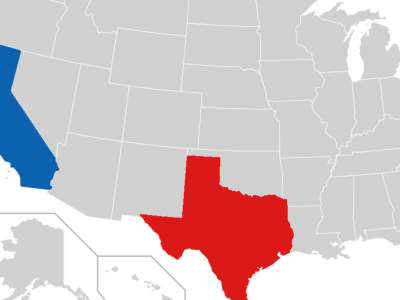Texas and California Are Not Opposites. Contrary to What You Might Think.
Legal Planet: Environmental Law and Policy 2024-10-10

There’s a common idea that Texas and California represent two opposing poles of America. They’re admittedly very different places on many levels. But in some respects, they are surprisingly similar, and some differences aren’t as big as they seem.
Let’s begin with politics. It’s true that one part is dominant in each state, but that’s where the resemblance ends. California is almost two-thirds Democratic, so you might think that Texas is probably the opposite – 2 to 1 Republican. Not so. For instance, in 2020, 63.5% of Californians voted for Biden. Trump did win comfortably in Texas, but with a smaller margin, 54% of the vote. If it weren’t for gerrymandering, the Texas legislature wouldn’t be nearly so one-sidedly Republican. It’s no wonder that Democrats daydream about winning Texas, though so far it has only been a dream.
Demographics are also more similar than you might think. California is 35% white, while Texas is at 42%. The percentage of Hispanics is nearly identical. The big difference is that Texas has a higher percentage of blacks, while California has the larger share of Asians. Given all the complaints about immigration coming out of Texas, you might think that it has a lot more immigrants than California, but it’s quite the opposite: A quarter of Californians are foreign-born, as opposed to only about one-sixth of Texans.
What about energy? Texas is identified with Big Oil, and there’s no doubting the state’s primacy in oil and gas production. But the oil industry in California isn’t negligible. California produces almost as much oil as Alaska – still a lot less than Texas, but not as stark a difference as you might think.
On the renewables side, many people are surprised to learn that Texas is by far the largest generator of wind power in the country. California is #1 in solar power (counting rooftop and utility-scale) – but Texas is #2.
I’m not saying the two states are the same. There are many points of difference, especially in terms of state-level policy. But they are not at opposite poles either. As always, reality is messier than our preconceptions.